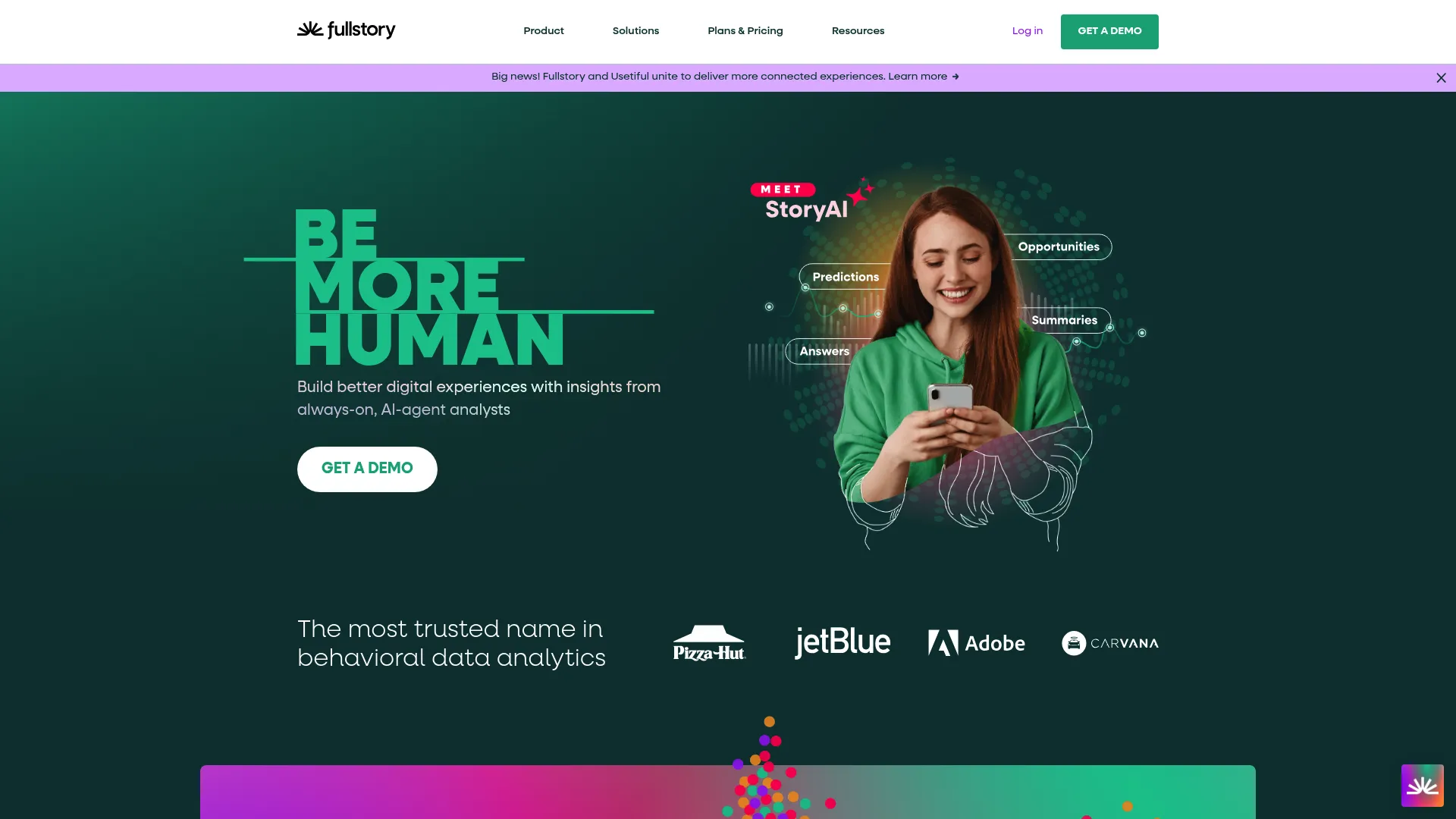
FullStory Review: The Complete Truth About This Premium Analytics Platform
Look, I’ll be straight with you – we’ve been using FullStory for the past six months, and it’s been a rollercoaster. After dealing with their sales team, wrestling with the interface, and getting hit with some eye-watering renewal quotes, I figured it was time to share what actually happens when you sign up for this thing.
This isn’t one of those fluff reviews where everything’s amazing. FullStory has some serious strengths, but man, does it come with baggage. If you’re thinking about dropping serious cash on this platform, you deserve to know what you’re getting into.
Table of Contents
- The Quick and Dirty Summary
- What FullStory Actually Is
- Better (and Cheaper) Options
- Questions Everyone Asks
- My Final Take
The Quick and Dirty Summary
Here’s the deal: FullStory is probably the most comprehensive session recording tool out there, but it’ll cost you. We’re talking $247/month minimum, and that’s just the starting point. The AI insights are genuinely helpful when they work, and the privacy stuff is bulletproof.
But here’s what nobody tells you – the performance gets wonky with lots of data, the interface will make your head spin at first, and their pricing is about as transparent as mud. Oh, and get ready for some serious sticker shock when renewal time comes around.
The support team is solid though, which honestly saved our bacon more than once during the learning curve from hell.
My Rating Breakdown
| What We Tested | Score | The Real Story |
|---|---|---|
| Features & Functionality | 4.5/5 | Does everything it promises, though the rage click thing flags normal behavior sometimes. The AI summaries actually save hours of manual work. |
| Easy to Use | 4/5 | Setup was dead simple – one code snippet and you’re done. But learning to actually use it? That’s a different story. Took our team weeks. |
| Price vs Value | 2.5/5 | This is where it hurts. No upfront pricing, crazy expensive, and they love surprise price hikes. Our quote went up 280% at renewal. |
| Performance | 3.5/5 | Works great until it doesn’t. Large datasets make it crawl, and sometimes replays just freeze mid-session. |
| Privacy & Security | 5/5 | Rock solid. If you need HIPAA, GDPR, all that regulatory stuff – they’ve got you covered completely. |
| Customer Support | 4/5 | Actually helpful humans who know their stuff. Documentation is thorough too. |
What FullStory Actually Is
What Everyone Knows Them For
FullStory built their reputation by recording literally everything your users do. And I mean everything – every click, scroll, hover, you name it. No manual event tracking, no gaps in data. It just captures it all automatically.
The AI stuff is where they really shine though. Instead of watching hours of session replays (been there, done that, wanted to cry), you get these automated summaries that actually tell you what matters. It’s like having a data analyst who never sleeps.
What sets them apart from basic heatmap tools is the depth. We’re not just talking about where people click – we’re seeing the complete user journey, including all the frustrating moments where they rage-click or give up entirely.

Screenshot of fullstory.com
The Features That Actually Matter
The autocapture thing is genuinely impressive. You install one piece of code and suddenly you’re recording every user interaction without having to set up tracking for each button, form, or link. It just works.
The frustration signals are pretty clever too. When users start rage-clicking or hitting dead ends, FullStory flags it automatically. Though I’ll be honest – sometimes it thinks normal clicking is rage-clicking, which can be confusing when you’re trying to prioritize fixes.
The heatmaps go way beyond the basic stuff. You can see scroll patterns, engagement zones, the works. But the real magic happens when you combine this with the session replays – you can actually watch someone struggle with your checkout process instead of just guessing what went wrong.
Integration-wise, they play nice with pretty much everything. Slack, Jira, Google Analytics – if you use it, they probably connect to it. Our team loves being able to share specific user sessions directly in Slack when we spot issues.
What’s Actually Good About It
The Data Collection is Unmatched
I’ve used a lot of analytics tools, and nothing captures user behavior like FullStory. Every interaction gets recorded automatically, so you’re not missing those weird edge cases that only happen when users do unexpected things.
This level of detail has saved us countless times when trying to figure out why conversions dropped or why users were bouncing from specific pages.
AI That Actually Helps
The automated insights aren’t just marketing fluff – they genuinely save time. Instead of manually combing through hundreds of sessions, the AI highlights the patterns that matter. Last month, it caught a mobile checkout issue that we would have missed otherwise.
Privacy Protection That Won’t Get You Sued
If you’re dealing with sensitive data or strict regulations, FullStory’s privacy features are bulletproof. GDPR, CCPA, HIPAA – they handle all of it. The automatic masking for credit cards and passwords works seamlessly too.
Real-Time Everything
Data shows up within minutes of users visiting your site. When our homepage broke last Tuesday, we knew about it almost immediately because we could see users hitting error states in real-time.
The Stuff That’ll Drive You Crazy
The Price Tag Will Make You Wince
Starting at $247/month for basic usage, and that’s just the beginning. They don’t publish real pricing anywhere – everything’s custom quotes. Our renewal quote came back 280% higher than our original price, and when I called to ask why, they basically said “market rates.”
I’ve talked to other users who’ve seen 400%+ increases. Budget accordingly.
The Learning Curve is Brutal
The interface is overwhelming at first. There are so many features, filters, and options that new team members need weeks to become productive. Our intern spent her first three days just trying to figure out how to create a simple funnel report.
The advanced features require serious time investment to master. Don’t expect to just jump in and start getting value immediately.
Performance Issues Are Real
When you’re dealing with high traffic volumes, things get sluggish. Session replays sometimes pause randomly, data takes forever to load, and the interface becomes less responsive. It’s frustrating when you’re trying to investigate urgent issues.
Some Features Are Hit or Miss
The rage click detection flags normal behavior sometimes. We’ve had it identify rapid clicking on image carousels as “user frustration” when people were just browsing normally. You learn to take some of the automated insights with a grain of salt.
How It Actually Performs
Features: 4.5/5
Does what it promises and then some. The autocapture and AI insights are genuinely valuable, even if some features need fine-tuning.
Usability: 4/5
Easy to implement, hard to master. The single code snippet setup is brilliant, but the interface complexity will slow down your team initially.
Value for Money: 2.5/5
This is the painful part. The lack of transparent pricing, high costs, and surprise renewal increases make it tough to justify for most businesses.
Technical Performance: 3.5/5
Generally reliable, but performance issues during high-traffic periods and occasional replay problems are annoying when you need the data most.
Privacy & Compliance: 5/5
Best-in-class. If you need bulletproof privacy protection, this is your tool.
Support: 4/5
Actually helpful support team with comprehensive docs. They know their product and respond quickly.
What Real Users Actually Say
The G2 reviews (4.5/5 stars from 764 people) paint a pretty accurate picture. Most people love the insights and data quality but hate the pricing. The comments section is full of “great product, terrible cost” feedback.
On Capterra, the pricing complaints are even more prominent. Multiple reviews mention having to switch to cheaper alternatives despite liking FullStory’s capabilities. That matches what I’ve seen in our industry Slack groups – everyone has a FullStory pricing horror story.
TrustRadius users mention reliability issues more frequently, especially around performance during high-traffic periods. Some enterprise customers question whether the ROI justifies the escalating costs as their usage grows.
I’ve noticed a pattern where companies start with FullStory during growth phases but migrate to cheaper solutions once the bills get out of hand. The value is there, but the pricing model doesn’t scale well for most businesses.
The Money Situation
Custom pricing only, starting around $247/month for 75,000 sessions. They have Business, Advanced, and Enterprise tiers, but good luck finding out what they actually cost without talking to sales.
The pricing is based on session volume, number of users, and how long you want to keep your data. Extra features cost extra money. The lack of transparent pricing makes budgeting a nightmare.
Here’s the kicker – renewal prices can jump dramatically. We’ve heard reports of 200-450% increases, and our own experience was a 280% jump with minimal explanation. Plan accordingly.
Where to Actually Get It
Direct from their website with a 14-day free trial. They also have a free plan that’s limited to 1,000 sessions monthly. Sign up at FullStory’s official website.
Just make sure you’re on their official site – the branding is pretty distinctive, so it’s hard to mistake.
Better (and Cheaper) Options
Hotjar
If FullStory’s pricing makes you nauseous, Hotjar starts at $32/month with actual transparent pricing. You get heatmaps, session recordings, and feedback tools without the premium price tag or complexity.
The feature set isn’t as comprehensive, but for most small to medium businesses, Hotjar covers 90% of what you actually need. Plus, you can actually budget for it without surprise renewal shocks. Check them out at their official website.
Userpilot
Userpilot combines session recordings with user onboarding and engagement tools. It’s particularly good for SaaS companies who want to improve user experience and conversion optimization in one platform.
The pricing is more reasonable than FullStory, and the onboarding features might eliminate the need for separate user engagement tools. Learn more at Userpilot’s website.
LogRocket
LogRocket targets technical teams by combining session replay with performance monitoring and error tracking. If your engineering team needs to identify bugs and performance issues alongside user behavior, this might be a better fit.
It’s more technical than FullStory but offers better development-focused features for teams that prioritize code quality and bug tracking. Visit LogRocket’s platform for more details.
Questions Everyone Asks
What does FullStory actually cost?
Starting around $247/month for 75,000 sessions, but everything’s custom pricing. The final cost depends on your usage, team size, and data retention needs. Be prepared for significant price increases at renewal – we’ve seen jumps of 200-450%.
You’ll need to talk to their sales team for real numbers, which makes budgeting a pain. I’d recommend getting quotes from alternatives before committing to anything long-term.
Is it worth the crazy high price?
Depends on your situation and budget. If you’re an enterprise with complex analytics needs and money to burn, the advanced features might justify the cost. For most small to medium businesses, you can get similar value from cheaper alternatives.
We found that the insights were valuable, but the ROI became questionable as costs escalated. Calculate your current conversion optimization budget and see if FullStory’s improvements would actually pay for itself.
Will it slow down my website?
The tracking code itself runs efficiently and shouldn’t impact your site’s performance significantly. However, analyzing high-volume sessions within the FullStory platform can be slow, with long loading times and occasional interface lag.
If you experience issues, their documentation has optimization guidelines, though in my experience, the performance problems are more on their end than yours.
How good is their privacy stuff?
This is actually FullStory’s strongest area. They automatically mask sensitive data like credit cards and passwords, and they’re fully compliant with GDPR, CCPA, HIPAA, and SOC 2. If you’re in a regulated industry, their privacy protection is bulletproof.
You’ll need to configure the masking rules properly for your specific use case, but once set up, it handles privacy protection seamlessly.
How long does setup actually take?
Basic implementation takes under an hour – just add their code snippet to your site. Data starts flowing immediately, and you’ll see insights within minutes.
But here’s the catch – mastering the platform and training your team takes much longer. Plan for several days of configuration and weeks of learning curve for advanced features. The help documentation is comprehensive, but there’s a lot to absorb.
Does it work well for mobile?
The mobile experience is okay but not great. FullStory captures mobile web sessions effectively, but the dedicated mobile app functionality feels limited compared to specialized mobile analytics tools.
If mobile is your primary focus, you might want to look at mobile-specific analytics platforms. FullStory works better as a desktop-first tool that also handles mobile rather than a true mobile analytics solution.
How well does it integrate with other tools?
Integration is one of FullStory’s strong points. Native connections to 50+ tools including Slack, Jira, Google Analytics, and major CRM platforms. Most integrations take just a few clicks to set up.
However, complex integrations sometimes need additional configuration. We had to work with their support team to get our Salesforce integration working properly, but once configured, data flows seamlessly between platforms.
How accurate is the rage click detection?
Hit or miss, honestly. It catches genuine user frustration sometimes but also flags normal behavior as problematic. We’ve seen it identify rapid clicking on image carousels or interactive elements as “rage clicks” when users were just browsing normally.
You’ll need to manually verify the alerts and adjust sensitivity settings. The feature is useful but requires human judgment to separate real frustration from normal interaction patterns.
My Final Take
FullStory delivers on its promises – comprehensive session recording, solid AI insights, and enterprise-grade privacy protection. If you’ve got the budget and patience for the learning curve, it can provide valuable user behavior insights that drive real improvements.
But let’s be real about the downsides. The pricing is brutal and unpredictable, the interface is overwhelming for beginners, and performance issues can be frustrating when you need data quickly. The lack of pricing transparency makes it nearly impossible to budget for growth.
I’ve seen too many companies get excited about FullStory’s capabilities during the trial period, only to get blindsided by renewal costs that blow up their analytics budget. The 280% price increase we experienced wasn’t unique – it’s a pattern.
Bottom line: if you’re an enterprise with deep pockets and complex analytics needs, FullStory might be worth the investment. For everyone else, start with a cheaper alternative that offers transparent pricing and simpler implementation. You can always upgrade later if you outgrow the basics.
Would I recommend it to a friend? Depends on the friend’s budget and tolerance for complexity. For most small to medium businesses, the juice isn’t worth the squeeze.





